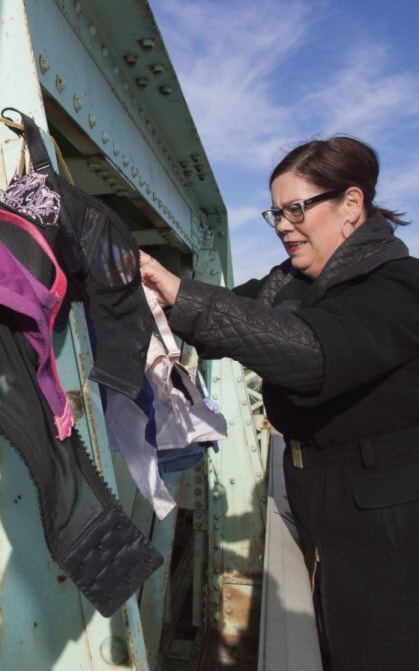Motorists and pedestrians had a somewhat distracting view last week as a colourful line of bras hung along the North Bridge.
The event was organized by Sherry Gummow, who was inspired by the Bras Across the River, breast cancer awareness initiative. She received large boxes of donated bras and hung them on the bridge Wednesday, Oct. 22.
Rather than focus on breast cancer, Gummow wanted to raise awareness of women’s issues and women who struggle with homelessness, not just in Alberta, but also right in Ponoka.
It’s an issue that is close to Gummow’s heart. “Thirty-five years ago I needed help because of abuse in an alcoholic relationship. There wasn’t a women’s shelter in Red Deer at the time,” she said.
She knows of women who have had to sleep under trees and in the foyers of banks in order to seek shelter from danger. Gummow says with the closest women’s shelters in Maskwacis, Camrose, Red Deer and then Rocky Mountain House, women who need help in Ponoka have to find a ride to get where they’re going.
“Homelessness could be for different reasons, it can be because we suffer from a mental illness. It can be by choice, it can be because you’ve been in a bad relationship and you’ve got nowhere to go,” said Gummow.
Representatives of the two shelters attended the event and were grateful for the donations. Nora-Lee Rear, executive director of the Camrose shelter, and Donna Potts-Johnson, vice-president of the Ermineskin Women’s Shelter, took some time to speak about their experiences helping women in need.
Potts-Johnson says many of the Ermineskin shelter’s clients deal with family violence and she says homeless for women aged 35 to 55-years-old is an issue they face on a regular basis.
“I think we need a second phase for teaching women how to live,” she explained.
There is a population of approximately 15,000 people in Maskwacis and Potts-Johnson says there are 400 families who are homeless. “We provide services for safety and also referrals for stepping away.”
The biggest challenges faced by women’s shelters appear to be access to more funding.
Rear feels the system makes it difficult for a woman to move forward.
She says if a woman has to leave a violent relationship, Alberta Works and Human Services is the next line of defense preventing a woman from returning to that home. The problem Rear sees is in how much money a woman actually receives.
“Alberta works (money) is barely enough to pay the rent, let alone everything else that comes with living on your own,” said Rear. “Many times a lot of our women end up returning simply for financial reasons.”
That issue can become more serious for a woman who is also a mother. Potts-Johnson added the funding for women’s shelters on the reserve compared to the cities is not equal. “It’s way less,” she said.
Rear says the Camrose shelter received 400 women who needed help but received 900 calls from women who needed help.
“It’s not a small issue, especially for the rural areas,” added Rear.
She suggests communities such as Ponoka need to start looking at ways of helping find solutions to these issues.
In an effort to help women with these issues, Gummow collects — year round — donated bras at her Busted Ladies Lingerie store and donates them to the Maskwacis and Camrose women’s shelters. She says until the end of October, every $50 spent at the store, a portion will go to purchasing items such as pajamas, underwear and socks.
A study, commissioned by the Alberta Centre for Child, Family and Community Research, looked at 20 rural communities in Alberta and discusses some of the challenges communities face. More information on the study can be found at www.research4children.com.
